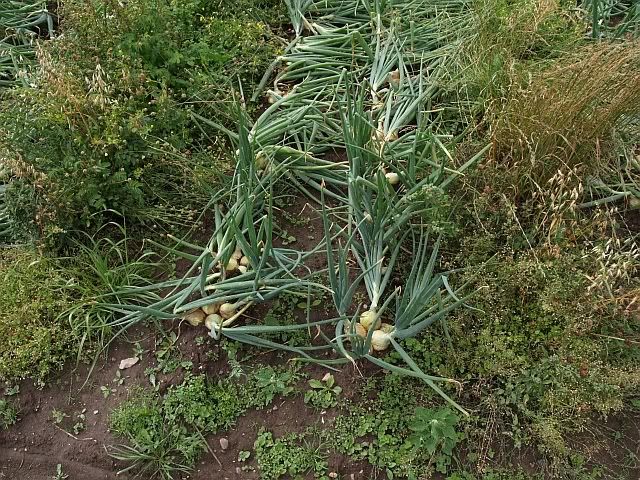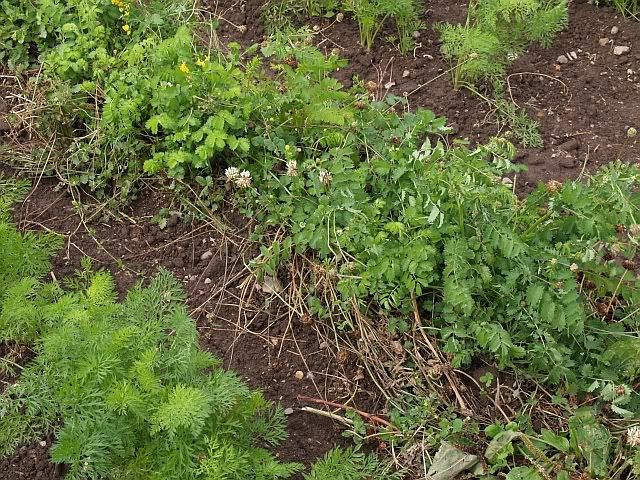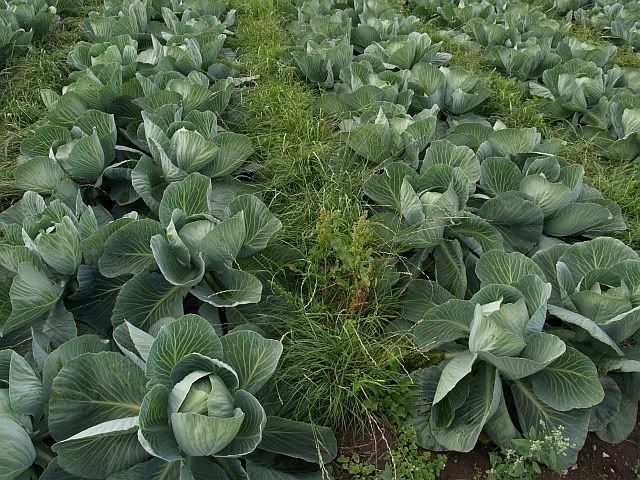Post by ottawagardener on Mar 3, 2009 8:15:18 GMT -5
While attending the Organic Growers of Ontario Eco Farm Day 2009, I heard a talk by Hida Manns with the fancy title of H. Ecological equilibrium: balancing weeds, insects and economics. I prefer to call it 'Benefits of a Weedy Vegetable Garden.'
I placed this post here because she uses a no-till method. Let me give you a synopsis of what I understood her technique to be. She raises goats so when she wants to start a vegetable bed, she takes their partially decomposed bedding that has been hanging in a barn over winter and then some time in the spring and lays it on a area of sod that she wants to convert (she recommends fall as the best time to start and so do I if you want to kill sod before planting). This is laid thickly to exclude light and inhibit weed growth through the mulch. In between the vegetable beds or paths, she lets the weeds grow.
Yup. She lets the weeds grow.
To manage the height of the weeds and presumedly lower light competition, she uses a sickle to keep them about 6 inches high. Pictures of her garden bed show that she isn't too concerned about the weeds that occasionally break through the mulched beds either. She has noticed that after several years of this there is a progression away from annual weeds to more perennial types.
Her soil is sandy and she finds that it is greatly approved. All the things you usually hear about no-till techniques such as better water retention AND drainage due in both cases to the addition of organic matter, better ecological soil health and surpressed weed growth apply.
She is a researcher so I'm presuming the results are based on studies (and she showed us some studies) that disease and pests damage are lower in these crops and compared to regular bare dirt methods, there is no difference in yield. So though traditional techniques may have less weeds and therefore growth competition, disease and pests losses were higher.
Other than improving soil tilth, the weedy growth creates a diverse habitat for all sorts of critters and raises a whole bunch of interesting questions for me.
(Maybe this should have gone into the general gardening section?)
1. How does this affect rotation as some of the 'weeds' will be hosts for some diseases? Do they act as alterative, perhaps even preferred victems of these pests and diseases - trap crops.
2. Would strip planting of wildlife meadows around or through a large vegetable garden act in a similar way. How about a hedgerow or meadow beside the field?
3. How about interplanting vegetables in a more complex way so that similar plants are not right beside each other (This presents problems for rotation)?
A couple comments:
1. Care would have to be taken when saving seeds that wild relatives are not mixing genetics unless that was desired.
2. Why keep to 6 inches. Some of the benefits of these plants would be as providing pollen. Some potential beneficial plants are at greater heights when flowering so a nearby meadow would seem like a good idea.
3. I suspect that sometimes the benefit to having a weedy garden is that the pests can't find the vegetables in admist the pleasant chaos. Can this be replicated in another way?
4. How about determining what is beneficial about the weeds and substituing less useful species for more useful species with comparable charateristis?
5. So for those of you with as much grass as cabbage, remember, you're participating in experimental research: ;D
;D
More thoughts?
(Yup, this is more than just soil building)
I placed this post here because she uses a no-till method. Let me give you a synopsis of what I understood her technique to be. She raises goats so when she wants to start a vegetable bed, she takes their partially decomposed bedding that has been hanging in a barn over winter and then some time in the spring and lays it on a area of sod that she wants to convert (she recommends fall as the best time to start and so do I if you want to kill sod before planting). This is laid thickly to exclude light and inhibit weed growth through the mulch. In between the vegetable beds or paths, she lets the weeds grow.
Yup. She lets the weeds grow.
To manage the height of the weeds and presumedly lower light competition, she uses a sickle to keep them about 6 inches high. Pictures of her garden bed show that she isn't too concerned about the weeds that occasionally break through the mulched beds either. She has noticed that after several years of this there is a progression away from annual weeds to more perennial types.
Her soil is sandy and she finds that it is greatly approved. All the things you usually hear about no-till techniques such as better water retention AND drainage due in both cases to the addition of organic matter, better ecological soil health and surpressed weed growth apply.
She is a researcher so I'm presuming the results are based on studies (and she showed us some studies) that disease and pests damage are lower in these crops and compared to regular bare dirt methods, there is no difference in yield. So though traditional techniques may have less weeds and therefore growth competition, disease and pests losses were higher.
Other than improving soil tilth, the weedy growth creates a diverse habitat for all sorts of critters and raises a whole bunch of interesting questions for me.
(Maybe this should have gone into the general gardening section?)
1. How does this affect rotation as some of the 'weeds' will be hosts for some diseases? Do they act as alterative, perhaps even preferred victems of these pests and diseases - trap crops.
2. Would strip planting of wildlife meadows around or through a large vegetable garden act in a similar way. How about a hedgerow or meadow beside the field?
3. How about interplanting vegetables in a more complex way so that similar plants are not right beside each other (This presents problems for rotation)?
A couple comments:
1. Care would have to be taken when saving seeds that wild relatives are not mixing genetics unless that was desired.
2. Why keep to 6 inches. Some of the benefits of these plants would be as providing pollen. Some potential beneficial plants are at greater heights when flowering so a nearby meadow would seem like a good idea.
3. I suspect that sometimes the benefit to having a weedy garden is that the pests can't find the vegetables in admist the pleasant chaos. Can this be replicated in another way?
4. How about determining what is beneficial about the weeds and substituing less useful species for more useful species with comparable charateristis?
5. So for those of you with as much grass as cabbage, remember, you're participating in experimental research:
 ;D
;DMore thoughts?
(Yup, this is more than just soil building)








